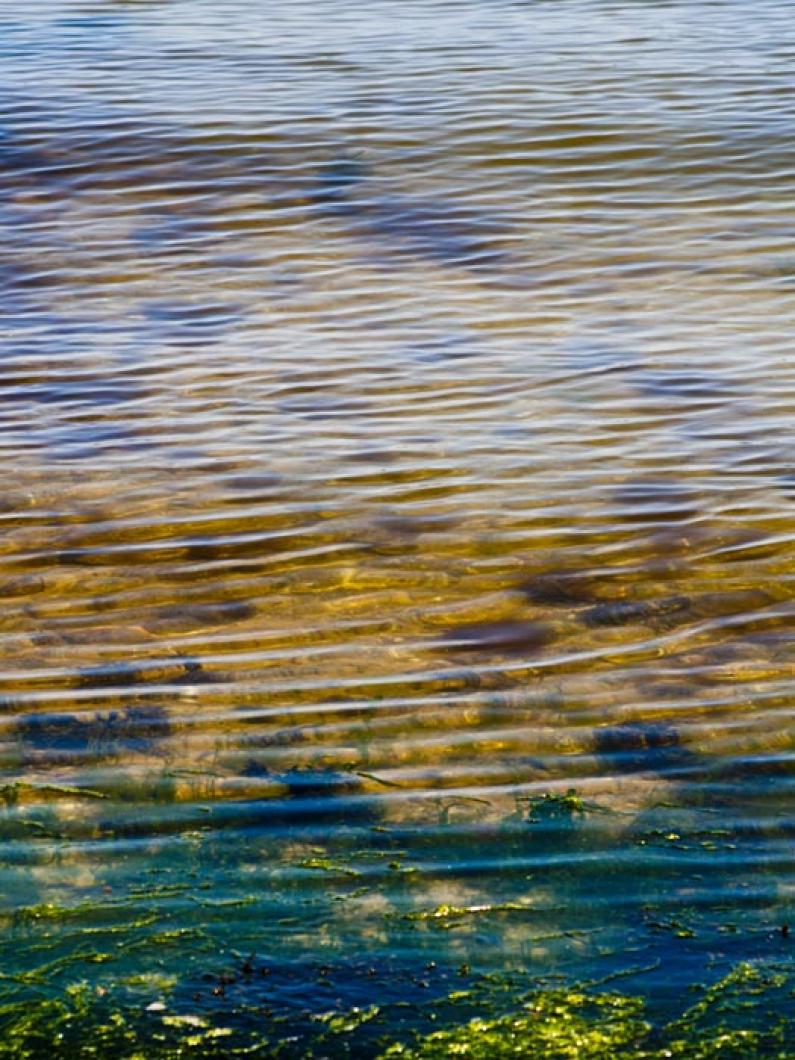On Thursday morning all was right with the Lagoon Pond. The water was clear, blue-green crystal, by all appearances the very picture of estuarine health. Just a day before, the water was clouded by an unsightly yellowish-brown fog from the head to the mouth of the Lagoon. It was an explosion of prorocentrum, an algae, and the largest one that Martha’s Vineyard Shellfish Group director Rick Karney has ever seen.
“This thing was so dramatic, it was beyond anything I’ve encountered,” he said at the hatchery yesterday morning. “Even Oak Bluffs shellfish constable Dave Grunden said he’s seen smaller clouds, but nothing like this.”
Prorocentrum is not harmful to humans but in the extreme can be fatal to shellfish. The event was what scientists generously refer to as a bloom, but Tisbury shellfish constable Danielle Ewart thought it made the Lagoon look more like river water. The bloom began last Friday and Mr. Karney was prepared for the worst, hastening his annual transfer of quahaug seed to the shellfish group’s Chappaquidick summer hatchery. But just as soon as it appeared it was gone.
“This end of the pond is the sickest part of the Lagoon so we expect weird stuff up here but to have it throughout the pond was really crazy,” Mr. Karney said. “Then it disappeared.”
On Thursday Gary Wikfors, a dinoflagellate expert at the NOAA Northeast Fisheries Science Center said the bloom was a mystery.
“There are couple of possibilities,” he said. “It could have been eaten by zooplankton, but Rick’s bag filters did not find planktonic grazers. It may have washed out, it may have sunk or maybe there was a big population of some kind of shrimp that ate it. I wish Rick had seen a whole lot of little animals in his filter bag because then we’d know where it went.”
Mr. Wikfors reiterated that prorocentrum poses no threat to human health.
On Thursday Mr. Karney put a sample of the organisms under a microscope. The protists are photosynthesizers and closely related to plants, but up close they appeared suprisingly mobile and autonomous. Some strode purposefully across the microscope slide while others swam in confused circles.
Lagoon Pond has recently been the subject of scrutiny by town officials and the state Department of Environmental Protection’s Massachusetts Estuaries Project. An estuaries project study presented this spring to Island officials and the public revealed that increased nitrogen levels in the pond introduced primarily by waterfront septic systems can fuel harmful algae blooms that have damaged the fish and shellfish-rearing eelgrass beds that once flourished on the Island. But, Mr. Wikfors said, this particular algae does not require a nitrogen-saturated environment and he cautioned about drawing a straight line between the pond’s health and this latest event.
“There has to be just enough nutrients to support the cells,” he said. “If you take the number of cells in a bloom and multiply it by the nitrogen in the cells, when I’ve done it for other prorocentrum blooms the nitrogen numbers are not that high.”
Mr. Wikfors compared the event to a typical late spring weekend when dandelions explode unexpectedly in backyards everywhere and vanish just as quickly.
“It’s really hard forecasting these blooms,” he said. “It’s one of the biggest challenges algae scientists face.”
Mr. Karney said that in his experience poor quahaug seasons have coincided with increased numbers of prorocentrum. The dinoflagellates irritate the tissues of shellfish and adult quahaugs may stop feeding altogether in their presence, dying about a week afterwards. When the pond went opaque last week it was immediate cause for worry, but Mr. Wikfors said barring an unlikely second bloom, the Lagoon had been spared.
“The fact that it disappeared before it could die off, that really saved you,” he said.






Comments
Comment policy »